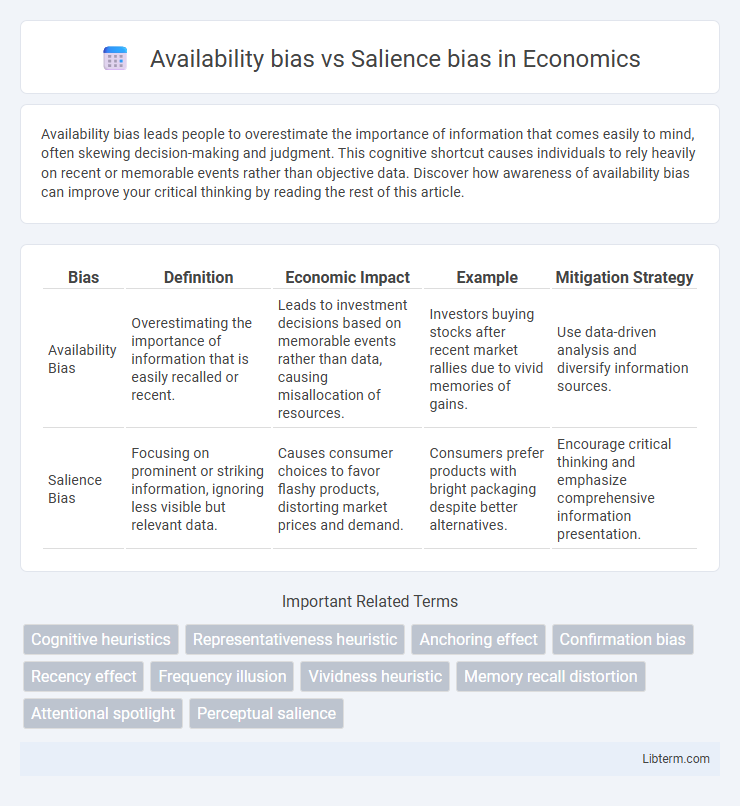Availability bias leads people to overestimate the importance of information that comes easily to mind, often skewing decision-making and judgment. This cognitive shortcut causes individuals to rely heavily on recent or memorable events rather than objective data. Discover how awareness of availability bias can improve your critical thinking by reading the rest of this article.
Table of Comparison
| Bias | Definition | Economic Impact | Example | Mitigation Strategy |
|---|---|---|---|---|
| Availability Bias | Overestimating the importance of information that is easily recalled or recent. | Leads to investment decisions based on memorable events rather than data, causing misallocation of resources. | Investors buying stocks after recent market rallies due to vivid memories of gains. | Use data-driven analysis and diversify information sources. |
| Salience Bias | Focusing on prominent or striking information, ignoring less visible but relevant data. | Causes consumer choices to favor flashy products, distorting market prices and demand. | Consumers prefer products with bright packaging despite better alternatives. | Encourage critical thinking and emphasize comprehensive information presentation. |
Understanding Availability Bias
Availability bias influences decision-making by relying heavily on immediate examples that come to mind, often leading to overestimations of event frequency or importance based on recent or memorable experiences. This cognitive shortcut causes individuals to judge the probability of events by the ease with which they recall similar instances, rather than through objective data analysis. Understanding availability bias helps in recognizing when intuitive judgments are skewed by vivid or recent memories, improving critical thinking and decision accuracy.
Defining Salience Bias
Salience bias refers to the cognitive tendency to focus on information or stimuli that are most prominent or emotionally striking, often ignoring less noticeable but equally important data. Unlike availability bias, which depends on how easily examples come to mind based on memory recall, salience bias is driven by the vividness or distinctiveness of the information in the present moment. This bias affects decision-making by skewing attention toward the most noticeable aspects rather than a balanced evaluation of all relevant information.
Cognitive Roots of Availability Bias
Availability bias stems from the cognitive tendency to rely on immediate examples that come to mind when evaluating a topic, often due to the ease of recall and recent exposure, which skews perception of probability and frequency. This bias originates from mental shortcuts, or heuristics, where the brain prioritizes information that is more readily retrievable, influenced by emotional impact and vividness of memories. Salience bias, by contrast, involves focusing attention on conspicuous or prominent stimuli, but availability bias specifically roots in the accessibility and memorability of information in cognitive processing.
Psychological Mechanisms Behind Salience Bias
Salience bias occurs when individuals disproportionately focus on information that stands out due to its vividness or emotional impact, influencing decision-making processes. The psychological mechanism behind salience bias involves enhanced attention and memory encoding of striking stimuli, driven by the brain's prioritization of novel or emotionally charged information. This bias contrasts with availability bias, which depends primarily on the ease of recalling past experiences rather than the inherent prominence of the stimuli.
Key Differences: Availability vs Salience Bias
Availability bias occurs when people judge the likelihood of events based on how easily examples come to mind, often influenced by recent exposure or vivid memories. Salience bias leads individuals to focus on the most noticeable or striking features of a situation, overshadowing less prominent but relevant information. The key difference lies in availability bias relying on memory accessibility, while salience bias depends on the prominence or distinctiveness of stimuli in the environment.
Real-World Examples of Availability Bias
Availability bias leads individuals to overestimate the likelihood of events based on recent or memorable examples, such as fearing plane crashes more than car accidents due to vivid media coverage. Salience bias causes people to focus on the most striking or noticeable information, often ignoring more relevant data, like investors reacting to dramatic stock market shifts instead of stable long-term trends. Real-world examples of availability bias include people avoiding certain foods after hearing about foodborne illness outbreaks or overestimating crime rates because of sensational news stories.
Everyday Situations Illustrating Salience Bias
Salience bias occurs when people focus disproportionately on vivid or emotionally striking information in everyday situations, such as fearing airplane crashes more than car accidents due to dramatic media coverage. Unlike availability bias, which depends on how easily examples come to mind, salience bias emphasizes the prominence or distinctiveness of the information itself. This can lead to distorted risk perceptions and decision-making based on attention-grabbing but statistically rare events.
Impact of Both Biases on Decision Making
Availability bias skews decision making by causing individuals to overestimate the probability of events that are more memorable or recent, leading to errors in risk assessment and judgment under uncertainty. Salience bias directs attention toward the most noticeable or emotionally striking information, overshadowing less conspicuous but relevant data, which can distort prioritization and choice outcomes. Both biases impair objective analysis by filtering information through simplified perceptions rather than comprehensive evaluation, increasing the likelihood of suboptimal decisions in personal, professional, and financial contexts.
Strategies to Overcome Availability and Salience Bias
To overcome availability bias, employ strategies such as seeking diverse information sources, performing thorough data analysis, and challenging initial impressions by considering alternative scenarios. Combat salience bias by prioritizing long-term implications over striking or emotionally charged details, employing systematic decision-making frameworks, and implementing structured checklists to ensure objective assessment. Both biases can be mitigated through critical thinking training and fostering an environment that encourages evidence-based decision-making.
The Role of Media in Amplifying Both Biases
The media plays a critical role in amplifying availability and salience biases by disproportionately highlighting sensational or easily recalled events, which shapes public perception and decision-making. Extensive coverage of dramatic incidents makes these events more cognitively accessible, leading individuals to overestimate their frequency and significance. This skewed representation influences behavior and attitudes, reinforcing biased judgments based on vivid media portrayals rather than balanced evidence.
Availability bias Infographic

 libterm.com
libterm.com